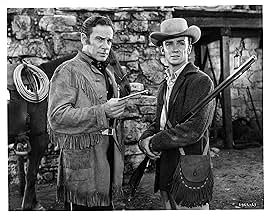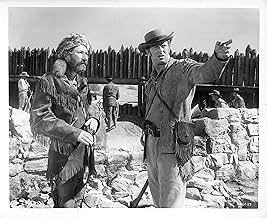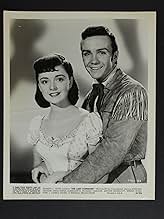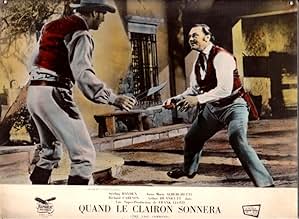VALUTAZIONE IMDb
6,3/10
1040
LA TUA VALUTAZIONE
Aggiungi una trama nella tua linguaModerate Jim Bowie leads rebellious Texicans--and Davy Crockett--in a last-ditch stand against his old friend, Santa Ana.Moderate Jim Bowie leads rebellious Texicans--and Davy Crockett--in a last-ditch stand against his old friend, Santa Ana.Moderate Jim Bowie leads rebellious Texicans--and Davy Crockett--in a last-ditch stand against his old friend, Santa Ana.
- Regia
- Sceneggiatura
- Star
Abdullah Abbas
- Townsman
- (non citato nei titoli originali)
Rico Alaniz
- Tomas
- (non citato nei titoli originali)
Recensioni in evidenza
Frankly, I don't watch movies expecting to see historical accuracy. Movies are basically a commercial product marketed to earn a profit, which means pleasing as large an audience as possible. So, if there's a conflict between historical accuracy and constructing a more saleable story, we know generally which factor will prevail. That's simply the way our capitalistic system works. Thus, well-intended folks should not be surprised at the liberties taken in this supposed account of events surrounding the siege of the Alamo.
That being said, I thought the movie was very enjoyable. I thought so back in 1955, and again the other night on TMC. It's a good lively cast. Hayden may not have liked his role, but he's motivated nonetheless—catch how much he puts into the emotional exhaustion when he raps in vain on a door and then faces the camera in near collapse. That's probably the most animated this fan of Hayden's has seen him in any movie. The under-rated Richard Carlson also delivers as Hayden's rival, and of course there's the inspired casting of Hunnicutt as Davy Crockett at a time when Disney's Crockett dominated the big screen and the pop music charts too. In fact, Hunnicutt's little speech after arriving at the fort amounts to a masterpiece of down-home eloquence. And Russell Simpson's parson of-very-few- words is just the kind of no-nonsense character you'd expect to find among a band of back- woodsmen. Too bad, however, that commercial factors required Alberghetti's role. She's fine as the teenage aristocrat, but the sub-plot pairing her with the very mature Hayden amounts to the movie's biggest drawback.
One thing lowly Republic was good at is action sequences. Here the battle scenes and spectacle are outstanding—the collapsing parapet is both surprising and especially well done. For sure, the studio knew how to get the most out of limited resources, even as constraints show up around the edges, particularly with painted backdrops. Nonetheless, the enemy is treated with due respect, and I particularly liked the elegiac final scene with the traumatized women and children. It's just the kind of somber mood fitting for what has happened. Of course, Republic's reputation as a cowboy studio would never get its product much attention from either the press or the artistic community. Nonetheless, this is a surprisingly well-mounted and entertaining feature that can hold its own against bigger- budget action features of its day. Too bad, its many merits have been so generally overlooked.
That being said, I thought the movie was very enjoyable. I thought so back in 1955, and again the other night on TMC. It's a good lively cast. Hayden may not have liked his role, but he's motivated nonetheless—catch how much he puts into the emotional exhaustion when he raps in vain on a door and then faces the camera in near collapse. That's probably the most animated this fan of Hayden's has seen him in any movie. The under-rated Richard Carlson also delivers as Hayden's rival, and of course there's the inspired casting of Hunnicutt as Davy Crockett at a time when Disney's Crockett dominated the big screen and the pop music charts too. In fact, Hunnicutt's little speech after arriving at the fort amounts to a masterpiece of down-home eloquence. And Russell Simpson's parson of-very-few- words is just the kind of no-nonsense character you'd expect to find among a band of back- woodsmen. Too bad, however, that commercial factors required Alberghetti's role. She's fine as the teenage aristocrat, but the sub-plot pairing her with the very mature Hayden amounts to the movie's biggest drawback.
One thing lowly Republic was good at is action sequences. Here the battle scenes and spectacle are outstanding—the collapsing parapet is both surprising and especially well done. For sure, the studio knew how to get the most out of limited resources, even as constraints show up around the edges, particularly with painted backdrops. Nonetheless, the enemy is treated with due respect, and I particularly liked the elegiac final scene with the traumatized women and children. It's just the kind of somber mood fitting for what has happened. Of course, Republic's reputation as a cowboy studio would never get its product much attention from either the press or the artistic community. Nonetheless, this is a surprisingly well-mounted and entertaining feature that can hold its own against bigger- budget action features of its day. Too bad, its many merits have been so generally overlooked.
In the habitual group of various characters we find the starring Jim Bowie of ¨Bowie knife¨ fame (Sterling Hayden) who held command until stricken with typhoid-pneumonia , Colonel William Barret Travis (Richard Carlson) , commander of the small garrison of some 180 men and Davy Crockett of Tenesse (Arthut Hunnicutt) who had arrived with a dozen volunteers . They're guarding El Alamo against a Mexican militia commanded by General Antonio Lopez De Santa Anna , President of Mexico (J. Carroll Nash) . They're featured in more realistic roles than successive films , though here predominates the melodrama . It's a spectacular film hampered by a tiring screenplay and including Max Steiner's excellent score with a title song by Gordon McRae . The motion picture well produced by Republic's founder , Herbert J. Yates, was professionally directed by Frank Lloyd . Subsequently , five years later , John Wayne made his own retelling : ¨El Álamo¨ (1960) , utilizing a lot of the still-standing sets that were used in this movie .
The film is rightly based on historic events , these are the followings : On 23 February 1836 a army of 5000 entered San Antonio. When Santa Anna demanded the surrender, William Travis answered with a cannon shot. So began thirteen day siege that ended with the Mexicans storming the fortress, the defenders, to a man , fought on until death .With bugles sounding the ¨deguello¨(signifying no quarter to the defenders) attacked the adobe walls from all four sides and broke through. Travis was shot dead over his cannon . Crockett using his rifle as a club, fell under a swarm of the enemy . Bowie fought to the last from his sickbead. The Mexicans had won a Pyrrhic victory suffering more than 1500 casualties. Forty six days after the fall ,less than 800 Texans and American volunteers led by General San Houston defeated Santa Anna and his army of 1300 at San Jacinto. Shouting ¨Remember the Alamo¨ Houston's men completely routed the Mexicans in a matter of minutes, killing 630 while losing only 8. Santa Anna was captured, and the Republic of Texas was born.
The film is rightly based on historic events , these are the followings : On 23 February 1836 a army of 5000 entered San Antonio. When Santa Anna demanded the surrender, William Travis answered with a cannon shot. So began thirteen day siege that ended with the Mexicans storming the fortress, the defenders, to a man , fought on until death .With bugles sounding the ¨deguello¨(signifying no quarter to the defenders) attacked the adobe walls from all four sides and broke through. Travis was shot dead over his cannon . Crockett using his rifle as a club, fell under a swarm of the enemy . Bowie fought to the last from his sickbead. The Mexicans had won a Pyrrhic victory suffering more than 1500 casualties. Forty six days after the fall ,less than 800 Texans and American volunteers led by General San Houston defeated Santa Anna and his army of 1300 at San Jacinto. Shouting ¨Remember the Alamo¨ Houston's men completely routed the Mexicans in a matter of minutes, killing 630 while losing only 8. Santa Anna was captured, and the Republic of Texas was born.
Made in spite by Yates, well shot and mounted, replete with an excellent cast, 'The Last Command' still remains good value even if it rather pales besides Wayne's grandiose epic of just a few years later. The much underrated Hayden is superb as "big Jim Bowie" and Hunnicutt equally as good as Davy Crockett. Hayden has the ability to appear gentle, naive, rugged and brusque all at once - something few other actors, with perhaps the exception of Spencer Tracy, managed. Unfortunately Crockett and his 29 men don't appear until some way in. With only Hayden's latent dynamism really keeping things afloat, the first half an hour of the film is rather talkative in exposition, and it drags somewhat. Consuela de Quesada (Anna Marie Alberghetti) is a limp romantic foil to Bowie - I for one would be happy to have seen her written out and the structure tightened through her absence. Ernest Borgnine plays his small role with gusto - his confrontation with Bowie a standout scene in a film full of fighting, although his later genial acceptance of Bowie's superiority as a man is perhaps emphasised by the script too much for comfort.
Steiner's music (and especially the superb title song) goes a long way in making events move smoothly towards the climax. For it's the Alamo Battle the bums on seats will have come to see, and here it is done well (although again not *as* well as Wayne would manage with considerable more time and resources later (although any comparison isn't too much to the present film's detriment).
In short this is well worth seeing, and it provides a contemporarily staged contrast to the better-known epic which was to follow. I'd still like to see an historically accurate account of the events at the mission, though...
Steiner's music (and especially the superb title song) goes a long way in making events move smoothly towards the climax. For it's the Alamo Battle the bums on seats will have come to see, and here it is done well (although again not *as* well as Wayne would manage with considerable more time and resources later (although any comparison isn't too much to the present film's detriment).
In short this is well worth seeing, and it provides a contemporarily staged contrast to the better-known epic which was to follow. I'd still like to see an historically accurate account of the events at the mission, though...
This is a version of the Alamo story often overlooked mainly because it focuses on Jim Bowie as opposed to Davy Crockett as the central character. Sterling Hayden in one of the many roles he truly hated before escaping to the seas is a stalwart and heroic Bowie.
As I said though in another review of a film with Bowie as the central character, Jim Bowie was anything but heroic. He was a land swindler, slave dealer, no good con man who very few people had anything nice to say about. He was a tough guy though, no question about that and the famous Bowie knife was made to his specifications.
Bowie was married into the Mexican aristocracy and did suffer the horrible tragedy of having his wife and children taken in an epidemic of the plague. We never see them here or in the John Wayne film or in the new Disney epic.
Possibly the best acting honors do go to Arthur Hunnicutt who was more the backwoods character that Davy Crockett was then John Wayne. Billy Bob Thornton in the 2004 Alamo was probably the best Davy Crockett ever put on film and the most accurate.
Probably too much is now known for the general public to appreciate a film like The Last Command. The principals at the Alamo were three dimensional characters and not the cardboard cutouts they are here.
As I said though in another review of a film with Bowie as the central character, Jim Bowie was anything but heroic. He was a land swindler, slave dealer, no good con man who very few people had anything nice to say about. He was a tough guy though, no question about that and the famous Bowie knife was made to his specifications.
Bowie was married into the Mexican aristocracy and did suffer the horrible tragedy of having his wife and children taken in an epidemic of the plague. We never see them here or in the John Wayne film or in the new Disney epic.
Possibly the best acting honors do go to Arthur Hunnicutt who was more the backwoods character that Davy Crockett was then John Wayne. Billy Bob Thornton in the 2004 Alamo was probably the best Davy Crockett ever put on film and the most accurate.
Probably too much is now known for the general public to appreciate a film like The Last Command. The principals at the Alamo were three dimensional characters and not the cardboard cutouts they are here.
'The Last Command' is a film with a better backstory than the film itself! First batted around Republic Pictures as a potential vehicle for John Wayne, the production was put on the back burner when Wayne decided he wanted total creative control, and decided to produce and direct his own version, with a budget Republic couldn't match.
Republic DID, however, have an arsenal of talent available, and a shooting script, and eventually brought in veteran director Frank Lloyd, who had just come off a ten-year hiatus with 'The Shanghai Story', in 1954. Sterling Hayden, fresh from the cult classic 'Johnny Guitar', and a featured role in Fox's lavish 'Prince Valiant', signed to play Jim Bowie ("I needed the money to refit my boat," he joked). Richard Carlson, whose 'Creature from the Black Lagoon' had just been released by Universal (becoming a big hit) was tapped to play Alamo commander William Barret Travis. Ernest Borgnine, whose 'Marty' was garnering rave reviews (and would earn him an Oscar) took on the showy supporting role of Bowie adversary/friend Mike Radin and starlet Anna Maria Alberghetti, in her first non-singing role, became the female lead. Two veteran character actors rounded out the major cast: J. Carrol Naish, as a sympathetic yet decisive Santa Anna, and, in an offbeat but inspired casting move, bearded Arthur Hunnicutt as a rustic Davy Crockett (who would very nearly steal the film!).
The production was very modestly budgeted, so much so that the number of extras serving as the Mexican army was limited, but director Lloyd and cinematographer Jack Marta were old hands at making more out of less, and with some judicious editing by Tony Martinelli, the illusion of thousands of Mexican soldiers was achieved. Set design was minimal, as well, and the famous 'look' of the church/fortress was often achieved through mat paintings.
Scored by the legendary Max Steiner, with a theme sung by Gordon MacRae, 'The Last Command' seemed to teeter at the edge between 'B' movie and 'A' status; ultimately, the pedestrian script, by Sy Bartlett and Warren Duff, did the movie in, as there was too much time spent on an unnecessary love triangle, which slowed much of the film to a crawl. Despite an unforgettable final battle, audiences avoided the film, and it quickly faded from sight.
Unfortunately, John Wayne didn't learn from 'The Last Command', and he added a love story to his 'Alamo', with the same lethargic result; Crockett's explosive demise (historically inaccurate, but rousing!) must have impressed him, as well, as he staged an even bigger version of it in his film.
'The Last Command' is a curio, but is enjoyable, for the most part, and the spectacular final assault makes it a must for any action fan's collection!
Republic DID, however, have an arsenal of talent available, and a shooting script, and eventually brought in veteran director Frank Lloyd, who had just come off a ten-year hiatus with 'The Shanghai Story', in 1954. Sterling Hayden, fresh from the cult classic 'Johnny Guitar', and a featured role in Fox's lavish 'Prince Valiant', signed to play Jim Bowie ("I needed the money to refit my boat," he joked). Richard Carlson, whose 'Creature from the Black Lagoon' had just been released by Universal (becoming a big hit) was tapped to play Alamo commander William Barret Travis. Ernest Borgnine, whose 'Marty' was garnering rave reviews (and would earn him an Oscar) took on the showy supporting role of Bowie adversary/friend Mike Radin and starlet Anna Maria Alberghetti, in her first non-singing role, became the female lead. Two veteran character actors rounded out the major cast: J. Carrol Naish, as a sympathetic yet decisive Santa Anna, and, in an offbeat but inspired casting move, bearded Arthur Hunnicutt as a rustic Davy Crockett (who would very nearly steal the film!).
The production was very modestly budgeted, so much so that the number of extras serving as the Mexican army was limited, but director Lloyd and cinematographer Jack Marta were old hands at making more out of less, and with some judicious editing by Tony Martinelli, the illusion of thousands of Mexican soldiers was achieved. Set design was minimal, as well, and the famous 'look' of the church/fortress was often achieved through mat paintings.
Scored by the legendary Max Steiner, with a theme sung by Gordon MacRae, 'The Last Command' seemed to teeter at the edge between 'B' movie and 'A' status; ultimately, the pedestrian script, by Sy Bartlett and Warren Duff, did the movie in, as there was too much time spent on an unnecessary love triangle, which slowed much of the film to a crawl. Despite an unforgettable final battle, audiences avoided the film, and it quickly faded from sight.
Unfortunately, John Wayne didn't learn from 'The Last Command', and he added a love story to his 'Alamo', with the same lethargic result; Crockett's explosive demise (historically inaccurate, but rousing!) must have impressed him, as well, as he staged an even bigger version of it in his film.
'The Last Command' is a curio, but is enjoyable, for the most part, and the spectacular final assault makes it a must for any action fan's collection!
Lo sapevi?
- QuizThe melody to "The Ballad of Rock Ridge" from the western spoof Mezzogiorno e mezzo di fuoco (1974) is taken almost note for note from this film's "Jim Bowie", sung by Gordon MacRae. Coincidentally, Slim Pickens appears in both films.
- BlooperWhen Gen. Santa Ana's cavalry charges toward the Alamo, the tire tracks of the camera truck are visible in front of the horses.
- ConnessioniFeatured in That's Action (1977)
- Colonne sonoreJim Bowie
by Sidney Clare and Max Steiner
Sung by Gordon MacRae
A Capitol Recording Artist
Arranged by Van Alexander (uncredited)
I più visti
Accedi per valutare e creare un elenco di titoli salvati per ottenere consigli personalizzati
- How long is The Last Command?Powered by Alexa
Dettagli
Botteghino
- Budget
- 2.193.939 USD (previsto)
- Tempo di esecuzione
- 1h 45min(105 min)
- Proporzioni
- 1.66 : 1
Contribuisci a questa pagina
Suggerisci una modifica o aggiungi i contenuti mancanti

























